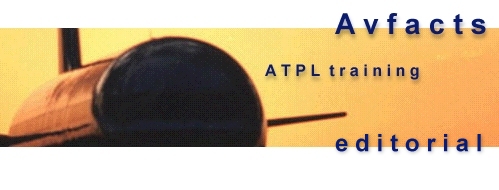




 |
 |
  |
 |
Performace & Navigation 3.
Effects of temperature on
TAS/IAS/Mach No. in cruise
| High flying
jet aircraft usually fly at a speed referenced to Mach number, rather than IAS or TAS.
This editorial discusses the effects (if any) that changing Outside Air Temperature (OAT)
has on IAS, TAS, and Mach number. Such questions are often part of the ATPL Performance or
Navigation examinations. Flight at constant level/Mach No./Increasing or Decreasing OAT When a constant Mach number is maintained at a constant level, penetrating an area of colder air will see NO change in IAS, but a decrease in TAS by approximately 1 kt per degree C. The reverse is the case when OAT is increasing, IAS unchanged, and TAS increasing. This is because the IAS gauge uses the same pitot and static port values as does the Machmeter. Both therefore will be effected equally by temperature/density changes. TAS decreases in cold air because the speed of sound decreases in colder air. When we maintain a fixed Mach number, we maintain a certain percentage value of the speed of sound. Therefore, if the speed of sound decreases we will also get a decrease in TAS. Effectively you are flying at a fixed percentage of a smaller number. Refer to diagram below.
|
||||
|
At a fixed Mach No. TAS will decrease if temperature decreases. | |||
 |
At a fixed Mach No. TAS will increase if temperature increases. | |||
 |
At a fixed Mach No., IAS remains unchanged when OAT changes. | |||
 |
Machmeter and IAS values compliment each other at a constant FL. |
|||
| FL310 |
|
|||
| Note that if you forget all this in
the exam, think up a scenario such as that above, and check out what happens to the values
using your circular navigation computer. Long Range Cruise is a variable Mach number schedule based on aircraft weight. Light weights = lower Mach No./Higher weight = higher Mach No. If temp and FL remain unchanged, then Mach No. and TAS will decrease as the flight progresses due to fuel burn off. Keep a watch on this site for more ATPL training editorials. Training texts on this and other ATPL topics are available from most pilot shops around Australia, and online through the Shop section of the aviationshop website. Rob Avery |
||||